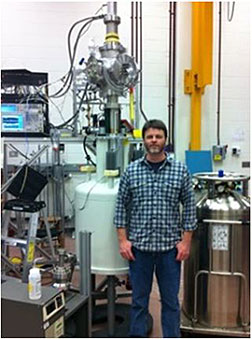- Number 441 |
- June 15, 2015
Chirping electrons: Cyclotron radiation from single electrons measured directly for first time

PNNL Physicist Brent VanDevender with the
Cyclotron Radiation Emission Spectroscopy
apparatus used to measure the energy of a
single electron from decaying Krypton-83m.
Measuring the cyclotron power radiated by a single electron in a magnetic field is a first, but it’s also another step toward answering some of the most pressing questions about the universe, according to scientists at DOE's Pacific Northwest National Laboratory (PNNL) who recently collaborated with others to accomplish that feat.
Physicist Brent VanDevender and his colleagues at PNNL, along with others from five research institutions, recently measured cyclotron radiation produced by single electrons from radioactive krypton-83m decays. They used a method they developed called Cyclotron Radiation Emission Spectroscopy (CRES). Cyclotron radiation was postulated in 1904 and later measured from groups of electrons, but the power from single electrons had never been observed.
“Everybody knew it would be there,” VanDevender explained. “We went looking for it.”
The collaborators’ success opens up grander possibilities for finding more answers scientists are pursuing. VanDevender recently received a DOE Office of Science Early Career Research Program award to fund additional research that would build on the newfound ability to measure a single electron’s energy: Measuring the energy—and hence the mass (weight)—of neutrinos, some of the smallest known subatomic particles. Neutrinos are the most common matter particles in the universe, accounting for at least as much energy as all the stars combined. Learning about them is currently one of the hottest questions for physicists because they are a key to understanding the basic properties of the universe.
Using tritium instead of krypton-83m in their next project, the scientists hope to extrapolate the energy of a neutrino by allowing tritium (or H-3, a hydrogen atom with two extra neutrons) to beta decay to helium-3. That will allow them to calculate the mass of a neutrino by adding the energies of the helium-3 and an electron. The difference between that and a tritium atom would be the energy that a departing neutrino takes with it. According to Einstein’s special theory of relativity, that energy (E) equals the mass of the neutrino multiplied by the speed of light squared (MC2).
“This research is on the cutting edge of fundamental physics,” said PNNL nuclear physicist Andrew Hime, who collaborates with VanDevender. “The question of neutrino mass is decades old and difficult to answer because it is very tiny. Its mass is smaller than the sensitivity of past experiments.
“Brent is lead investigator and he and his colleagues developed CRES,” said Hime. “It adds another factor of 10 in sensitivity compared to the state of the art for measuring energy from electrons. Since that energy is shared with neutrinos, measuring their mass is possible.”
VanDevender agreed that determining the mass of a neutrino “is the most straightforward data analysis. But it is an extremely high-precision measurement and we need to measure electrons in much larger volumes—a couple of cubic meters. We made the procedure work, but now we have to make it big.”
VanDevender’s research could be big in a number of other ways, as well, according to Hime. There could be implications for understanding how the fundamental forces of nature were unified during the early epochs of the Big Bang. These tiny particles may provide answers to other questions, including how large-scale structures evolved in the universe and why it is dominated by matter instead of antimatter.
“It is remarkable to think that the most elusive and weakly interacting particles in Nature—neutrinos—might be the reason why we are here,” Hime said.
Read more.Submitted by DOE’s Pacific Northwest National Laboratory
